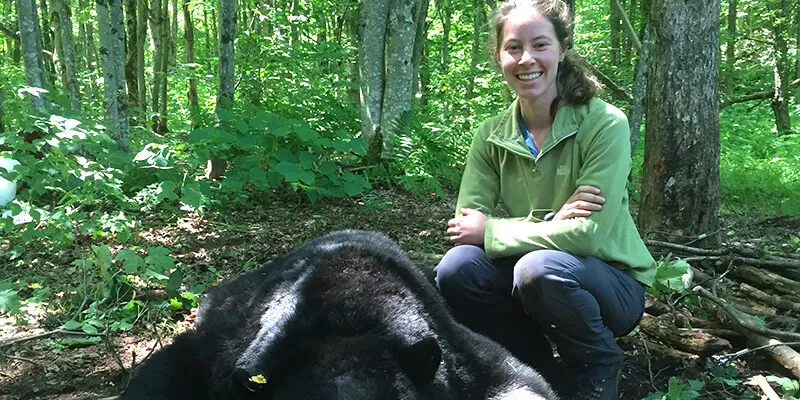I interned with the Vermont Fish and Wildlife Department (VFWD) on the Deerfield Wind Black Bear Study as a Perennial intern. Iberdrola, an energy company, is installing a series of wind turbines on two ridgelines in southern Vermont. These turbines are being installed on ridgetops populated by bear-scarred beech. American beech (Fagus grandifolia) nuts are important food for black bears in the fall. The Deerfield Wind Black Bear study is assessing the impact of the installation and running of these wind turbines on black bear movement, habitat use, and human interactions. This summer, I assisted Jaclyn Comeau, the lead researcher on the study, with baiting, trapping, and radio collaring bears, as well as with wildlife camera collection and data entry.
My first learning objective was to be confident conducting field research on black bears with a team of state biologists and technicians. I worked with many different wildlife professionals in both the Forest Service and Fish & Wildlife from biologists, to game wardens, to seasonal employees. Working with different professionals allowed me to gain confidence conducting field research. I was able to learn from them about their different career paths and what it is like to work in the wildlife biology field. I also learned a lot about how an agency such as the VFWD works.
My second learning objective was to understand the frequency of bear-human conflicts in Vermont, and the different forms of conflict. I learned about different forms of bear-human conflict throughout the summer. I was able to learn how VFWD dealt with bear-human interactions whether that was talking to a landowner about solutions for nuisance bears on her property or talking with landowners who had just had their dog killed by a bear. Solutions ranged from hazing bears, to relocating them, to killing them. The focus of the study also exemplifies the indirect interactions we can have with bears through the construction of the turbines.
My third learning objective was to be confident entering and managing photo-based data into the Colorado Parks & Wildlife (CPW) Photo Warehouse and related software. After the field season, I helped enter data from wildlife cameras into the CPW Photo Warehouse, as well as enter other data from the study into Excel. I enjoyed learning how to enter and organize large quantities of data and learning how to troubleshoot when things went wrong.
Getting to work closely with a large mammalian species, such as black bear, is a rare opportunity as an undergraduate student. I am so grateful that the perennial internship program exists and gives Rubenstein students a chance to gain valuable experience as an undergraduate. Future interns should be passionate and excited about what they are doing and not procrastinate on their internship requirements! I would recommend any intern to ask as many questions as possible to the professionals that he or she is working with. I loved talking to wildlife professionals and asking as many questions as possible to learn more about different career paths in the field of wildlife biology.
